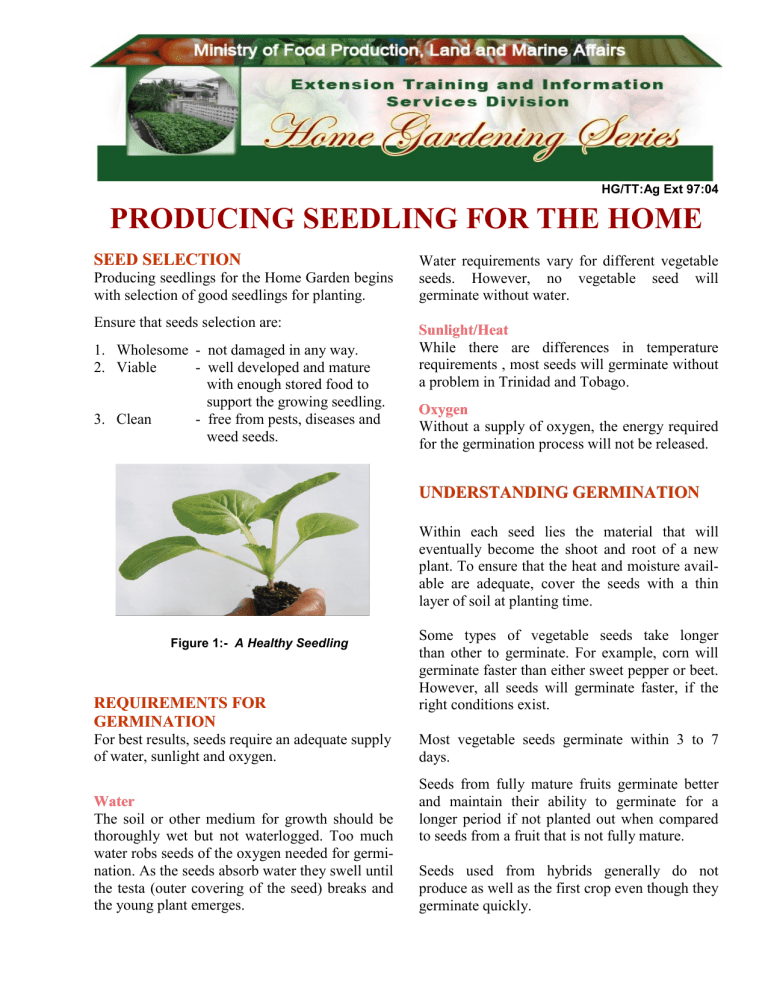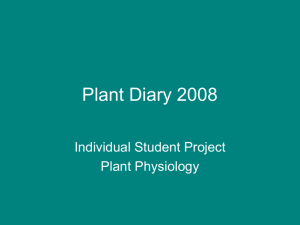
HG/TT:Ag Ext 97:04 PRODUCING SEEDLING FOR THE HOME SEED SELECTION Water requirements vary for different vegetable seeds. However, no vegetable seed will germinate without water. Ensure that seeds selection are: Sunlight/Heat While there are differences in temperature requirements , most seeds will germinate without a problem in Trinidad and Tobago. Producing seedlings for the Home Garden begins with selection of good seedlings for planting. 1. Wholesome - not damaged in any way. 2. Viable - well developed and mature with enough stored food to support the growing seedling. 3. Clean - free from pests, diseases and weed seeds. Oxygen Without a supply of oxygen, the energy required for the germination process will not be released. UNDERSTANDING GERMINATION Within each seed lies the material that will eventually become the shoot and root of a new plant. To ensure that the heat and moisture available are adequate, cover the seeds with a thin layer of soil at planting time. Figure 1:- A Healthy Seedling REQUIREMENTS FOR GERMINATION For best results, seeds require an adequate supply of water, sunlight and oxygen. Water The soil or other medium for growth should be thoroughly wet but not waterlogged. Too much water robs seeds of the oxygen needed for germination. As the seeds absorb water they swell until the testa (outer covering of the seed) breaks and the young plant emerges. Some types of vegetable seeds take longer than other to germinate. For example, corn will germinate faster than either sweet pepper or beet. However, all seeds will germinate faster, if the right conditions exist. Most vegetable seeds germinate within 3 to 7 days. Seeds from fully mature fruits germinate better and maintain their ability to germinate for a longer period if not planted out when compared to seeds from a fruit that is not fully mature. Seeds used from hybrids generally do not produce as well as the first crop even though they germinate quickly. SOWING THE SEEDS Seeds can be sown in soil in a mixture of sand, soil and manure, or combinations of these and other materials. The ideal mixture should have a fine texture and allow for good drainage. A general purpose seedling mix can be made by thoroughly mixing equal parts of soil, sand and well rotted manure. Ideally, the mix should be sifted through 0.6 cm (¼ in) mesh wire before filling seedling boxes, bags or styrofoam cups. It is advisable to sow some seeds (corn, peas, beans, cucumbers, pumpkins) directly into the soil where they will grow and mature. Others (tomatoes, lettuce, patchoi, celery) should be sown in a variety of containers such as seed boxes, bags, trays, cups or tins for transplanting later on. SEEDLINGS Sow 2 to 3 seeds for every seedling to be transplanted. Thinning out involves the selection and careful removal of individual seedlings from where they were sown. Each seedling which is removed is planted into another container to further develop. Thinning should only be carried out when seedlings get to the 2 - leaf stage. Figure 4:- Seedlings After Thinning Out CARE OF SEEDLINGS Too much sunlight is bad for young seedlings. Some shade is required. Shade can be reduced as the plants get older. Water the seedlings twice per day. The afternoon watering should be done in the early afternoon (2 to 4 p.m.) to allow plants to dry out before nightfall. The practice will help to reduce disease problems at the seedling stage. Apply a complete NPK fertilizer as a foliar spray once per week. It is very important that pest and diseases problems be properly diagnosed before any control measure, (especially chemical) is undertaken. Pest and diseases management is best achieved by daily inspection of the nursery. Transplanting is usually done when plants are about 2 to 3 weeks old (approximately) 4 to 6 leaf stage. Figure 3:- Seedlings Before Thinning Out "All rights reserved. No part of this publication may be reproduced, stored in a retrieval system, transmitted in any form, or by any means reproduced without permission in writing, of the Ministry of Food Production, Land and Marine Affairs." Published and Printed by the Extension, Training and Information Services Division Ministry of Food Production, Land and Marine Affairs Trinidad and Tobago February 1999 Technical content revised September 2009 Reprinted September 2009


